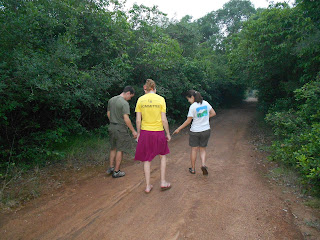...more on that later.
On Friday we took a day trip to Kanchipuram, which is a few hours away from MCC. Our first stop was at a sari shop. Several girls bought saris to wear for Diwali. Sari buying is a really complicated process...first you have to pick out the actual sari that you want, then the blouse piece and skirt have to match. Amazingly we got out of the store in about an hour and managed to buy saris for 10 girls. We ate lunch at this really good vegetarian restaurant. It might have been the best food I've had yet. I shared cashewnut naan, cauliflower curry, and some kind of vegetable dumpling curry with Serena.
After lunch we stopped by a weaver's house and watched some men making wedding saris. It was incredible to see them making the fabric by hand. The machine was so intricate and complicated. We also stopped by a potter's house and watched him throw pots and jars. Some of the girls in the group tried their hand at throwing pots too.
Okay, now for the rice paddy story.
On the way back from the potter's we stopped to look at a rice paddy. We were walking out on a small strip of solid ground and somehow I managed to slip in the ditch and fall into the rice paddy. And then I fell in again while I was trying to get out. I only got a little mud on my shoes, but after that I was pretty much done with looking at rice. And apparently Suresh got a picture of it. How nice of him.
The next stop was at the beedi (cigarettes) maker's house. Since I had no interest in smoking, I took pictures of the village kids. They absolutely loved having their photos taken. It was super cute. Our final stop was to see a dance performance arranged by Suresh's in-laws. It was pretty incredible. I can't even imagine all the practice it must take to do that. We finally got around to dinner at 9:00 and didn't get back to MCC until 1:00 in the morning. All in all it was a pretty good day.
On Saturday we slept in and headed into the city of Chennai after lunch. We stopped at a musical instrument shop and then we went to the mall. It was pretty much like an American mall, but there was a weird mix of Western and Indian stores.
I'll try to get some pictures up later...
On Friday we took a day trip to Kanchipuram, which is a few hours away from MCC. Our first stop was at a sari shop. Several girls bought saris to wear for Diwali. Sari buying is a really complicated process...first you have to pick out the actual sari that you want, then the blouse piece and skirt have to match. Amazingly we got out of the store in about an hour and managed to buy saris for 10 girls. We ate lunch at this really good vegetarian restaurant. It might have been the best food I've had yet. I shared cashewnut naan, cauliflower curry, and some kind of vegetable dumpling curry with Serena.
After lunch we stopped by a weaver's house and watched some men making wedding saris. It was incredible to see them making the fabric by hand. The machine was so intricate and complicated. We also stopped by a potter's house and watched him throw pots and jars. Some of the girls in the group tried their hand at throwing pots too.
Okay, now for the rice paddy story.
On the way back from the potter's we stopped to look at a rice paddy. We were walking out on a small strip of solid ground and somehow I managed to slip in the ditch and fall into the rice paddy. And then I fell in again while I was trying to get out. I only got a little mud on my shoes, but after that I was pretty much done with looking at rice. And apparently Suresh got a picture of it. How nice of him.
The next stop was at the beedi (cigarettes) maker's house. Since I had no interest in smoking, I took pictures of the village kids. They absolutely loved having their photos taken. It was super cute. Our final stop was to see a dance performance arranged by Suresh's in-laws. It was pretty incredible. I can't even imagine all the practice it must take to do that. We finally got around to dinner at 9:00 and didn't get back to MCC until 1:00 in the morning. All in all it was a pretty good day.
On Saturday we slept in and headed into the city of Chennai after lunch. We stopped at a musical instrument shop and then we went to the mall. It was pretty much like an American mall, but there was a weird mix of Western and Indian stores.
I'll try to get some pictures up later...






